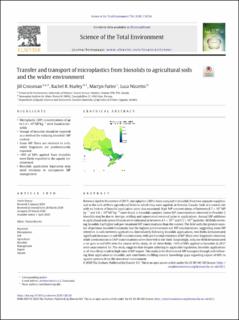| dc.contributor.author | Crossman, Jill | |
| dc.contributor.author | Hurley, Rachel | |
| dc.contributor.author | Futter, Martyn N. | |
| dc.contributor.author | Nizzetto, Luca | |
| dc.date.accessioned | 2020-09-10T13:02:38Z | |
| dc.date.available | 2020-09-10T13:02:38Z | |
| dc.date.created | 2020-09-05T14:14:52Z | |
| dc.date.issued | 2020 | |
| dc.identifier.citation | Science of the Total Environment. 2020, 724, 138334. | en_US |
| dc.identifier.issn | 0048-9697 | |
| dc.identifier.uri | https://hdl.handle.net/11250/2677285 | |
| dc.description.abstract | Between April to November of 2017, microplastics (MPs) were analysed in biosolids from two separate suppliers, and in the soils of three agricultural fields to which they were applied, in Ontario, Canada. Soils of a control site with no history of biosolid application were also examined. High MP concentrations of between 8.7 × 103 MP kg−1 and 1.4 × 104 MP kg−1 were found in biosolids samples. Lower MP concentrations observed in Provider 2 biosolids may be due to storage, settling and supernatant removal prior to applications. Annual MP additions to agricultural soils across Ontario were estimated at between 4.1 × 1011 and 1.3 × 1012 particles. All fields receiving biosolids had higher soil pre-treatment MP concentrations than the control. The field with the greatest number of previous biosolid treatments had the highest pre-treatment soil MP concentrations; suggesting some MP retention in soils between applications. Immediately following biosolids applications, two fields demonstrated significant increases in soil MP concentrations, with preferential retention of MP fibers over fragments observed, while a reduction in soil MP concentrations were observed in the third. Surprisingly, only one field demonstrated a net gain in soil MPs over the course of the study. At all three fields, >99% of MPs applied in biosolids in 2017 were unaccounted for. The study suggests that despite adhering to applicable legislation, biosolids applications at all sites likely result in high rates of MP export. This study is the first to track MP transport through soils following their application in biosolids, and contributes to filling current knowledge gaps regarding export of MPs to aquatic systems from the terrestrial environment. | en_US |
| dc.language.iso | eng | en_US |
| dc.publisher | Elsevier | en_US |
| dc.rights | Attribution-NonCommercial-NoDerivatives 4.0 Internasjonal | * |
| dc.rights.uri | http://creativecommons.org/licenses/by-nc-nd/4.0/deed.no | * |
| dc.title | Transfer and transport of microplastics from biosolids to agricultural soils and the wider environment | en_US |
| dc.type | Peer reviewed | en_US |
| dc.type | Journal article | en_US |
| dc.description.version | publishedVersion | en_US |
| dc.source.pagenumber | 9 | en_US |
| dc.source.volume | 724 | en_US |
| dc.source.journal | Science of the Total Environment | en_US |
| dc.identifier.doi | 10.1016/j.scitotenv.2020.138334 | |
| dc.identifier.cristin | 1827531 | |
| cristin.ispublished | true | |
| cristin.fulltext | original | |
| cristin.qualitycode | 2 | |

